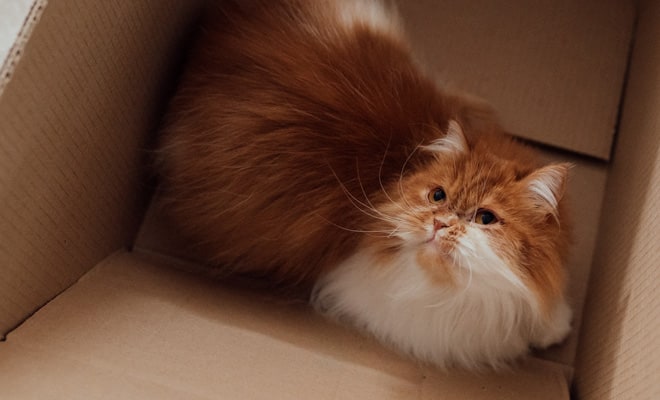Feline Groovy?
Even if you play Simon & Garfunkel, burn incense and drink chamomile tea all day, moving home is one of the most stressful things a human being can ever do. It ranks up there with managing England, fighting in a war or getting your kids into a secondary school with a decent OFSTED rating.
But imagine how much worse it’d be if you couldn’t use bubble wrap, didn’t drive a van, and had paws instead of hands. While there’s a lot that cats are good at, moving home isn’t one of them.
All that mess, stress and heavy lifting really isn’t their thing. Poor animals. Their whole world turned upside down, territory invaded, favourite hiding places dismantled, scratching-post de-rigged, cupboards, cushions and cat-flaps flat-packed away (happily, Attic can provide appropriate storage space with 24 hour access, 365 days a year).
If you want to reduce the disruption of a move on your pet, you need to try and see things from their point of view.
Make A Safe Space For Your Pet When Moving
Create a chill out zone for the cat in both your old home and the new space that you’re moving into. A quiet, secluded place, where your pet can eat, sleep, and lay low while you’re dismantling wardrobes, shifting sofas and dropping the entire cutlery drawer.
The main trick is to keep Tabitha Twitchit calm, happy and unstressed. Furnish her designated safe haven with familiar items – food and water bowls, a favourite blanket, some toys and a few treats. Creating a space filled with comforting items and smells is a sure fire way to make your cat feel at home in your new home.
Keep Your Cat Happy During A House Move: Pheromones, Catnip and Bribery
Have you noticed your cat rubbing its head against your legs, furniture and door frames? This isn’t some touchy feely display of affection for you or your choice of home. It’s the way that cats mark their territory and, if done excessively, is a sign your animal is stressed and doesn’t feel safe. If you’ve got a particularly troubled Tom, he might go so far as spraying or urinating all over your carpets and skirting boards, and not even the most committed cat lover wants to be dealing with that.
Keep calm, don’t panic. Follow the (veterinary) science and you can keep your cat happy, content and cool, like cats are supposed to be. It’s all about the pheromones, baby. Studies have shown that cat calming plug-in diffusers can help reduce common anxiety-related behaviours in your pet.
They release calming synthetic (odourless to humans) pheromones to spread comfort and joy by sending reassuringly scented messages via their cute button noses straight into their brains. Catnip and fish flavoured treats are much appreciated too.
Use A Cat Carrier: Avoid A Catastrophe When Moving
Use a portable cage, basket or cat carrier when you’re moving your precious cargo. But don’t leave it until the last moment to coax your pet inside. Get the carrier out a few days before the move, so your pet can get used to seeing it sitting there, waiting. You don’t want an older cat freaking out because it associates the transport method with previous unpleasant trips to the vet or incarceration in the local cattery.
Put treats or cat toys inside the cage to encourage your animal to view it less as a prison and more as a safe refuge from the madness of the move.
Butter Their Paws – Not too sure about this one
There’s an old wife-of-a-fisherman’s tale that says you should butter your cat’s paws upon moving to a new home. The logic being that the butter will take away the smell of their old home, and the feline will simply curl up in a corner to focus on licking its paws clean. Oh purr-lease! What nonsense.
Grease, butter and all things dairy (including cream and milk) are not only unhealthy for your cat’s digestive system, but cats aren’t idiots when it comes to navigation. They have a keen sense of sight and smell, and are more than capable of finding their way to and from the place where they feel safe, fed and nurtured. Put that butter knife down!
Get Your Cat Used To Their New Home
Get your cat used to the interior layout of your new property before you think about letting them stray outside. They need time to adjust and settle into their home surroundings. You may find a particularly stressed or scared cat may hide itself away for several days before their natural curiosity gets the better of them and they venture out from under the bed to explore.
If you have windows with any kind of a view, you can be sure your cat will be checking out the lie of the land before he or she risks going outside. Don’t rush Mr. Tiddles. Especially if Mr. Tiddles is a pedigree house cat finding his (unbuttered) feet in a brand new house.
New Cat On The Block
If you’re lucky enough to have a garden or private outdoor space, introduce your cat to it gradually and sensitively. Remember, cats are territorial animals and, as a new arrival, your little warrior may need to establish his authority over his domain by tooth, claw and doing his business in the bushes.
Foxes will generally stay away from your garden once they know there’s a cat or dog present. Thankfully, the same goes for mice, rats, pigeons and cabbage white butterflies. Although don’t be surprised if you find a dead one on the doorstep by way of a housewarming present from the new sheriff in town.
Schrödinger’s Cardboard Box
The most important thing when packing and unpacking is to make sure you don’t inadvertently pack your cat. We suggest you keep any curious felines, especially one’s called Schrödinger, out of boxes that contain geiger counters, flasks of poison or deeply disturbing paradoxes of theoretical quantum mechanics.
What is it with cats and cardboard boxes anyway?

An empty storage container seems to bring out the playful kitten in any feline. Like a cave or tree hollow was to its animal ancestors, a cardboard box seems to be a place to hide, sleep, lay in wait, pounce, eat and feel secure.
Every branch of Attic Self Storage is, of course, happy to offer a complete instore range of packing and moving materials, including cat-friendly flat-packed cardboard boxes in a variety of dimensions. From XS fluffy kitten size right up to XXXL adult Bengal tiger.
Tip For Moving House With A Dog
Most of the suggestions we’ve made with regards to cats could equally well apply to dogs. Keep their stress levels down. Create a safe space for them to sleep, with food, water and chew toys readily available. Introduce them to their new environment and neighbours calmly, gently and gracefully.
If you’re friendly, your dog will follow your lead. If you whip open the back door, yelling “sick ‘em!”, your best friend is likely to display more challenging behaviour. Remember, dogs are pack animals and as long as they know their place in the pack, they are remarkably resilient, fast to adapt and always ready to chase every last squirrel, fox, pigeon, deer, duck, cow, sheep and, yes, cat, out of your garden.
Moving House: Cats Vs Dogs
Dogs will love you, leap up and lick you at the drop of a hat. Cats are more selective about dispensing their affections or displaying their emotions. They’ll sit on your lap when they’re good and ready to sit on your lap. If the food you provide for them isn’t up to standard and there’s fresh salmon on offer at number 37, don’t expect to see hide nor hair of them for a few days.
On a more reliable note, if your cat raises its tail and shows you its backside, it’s signalling that it trusts you. You should feel truly honoured, bearing in mind that cats were once worshipped as gods by the Ancient Egyptians (cats have never forgotten this).
Cattic Self Storage
If you’re worried about making a move with your treasured family pet, Attic Self Storage always has someone on hand to give you sensible advice about storage space, measuring up, packing materials, logistics and moving-in dates. We’ll even let you use our free wi-fi to google ‘Cat Whisperer’, ‘Dog Walker’ or ‘Guinea Pig Behavioural Psychologist’ if you like.
We aim to accommodate every animal lover’s need for additional space, whether you’re moving into a student flat with a goldfish or a new family home with all the inhabitants of a fully-laden ark.
The team at Attic knows exactly how to help, because we’ve been through the same stress ourselves. And trust us, moving home with a pet of any age, species or breed is a whole bunch easier than moving with a human being under the age of 12.


